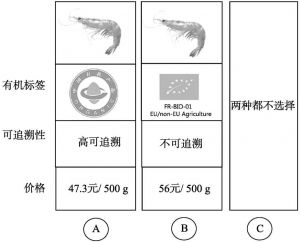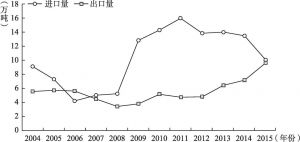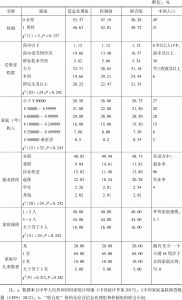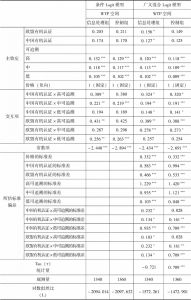摘要
虽然中国的水产品可追溯体系正在不断完善和推广,但是对于消费者而言,由于缺乏相关研究,认知能力十分有限。本文研究了有机认证与可追溯信息对消费者选择南美白对虾的影响,研究发现:消费者对于非可追溯中国有机认证南美白对虾的支付意愿显著低于可追溯中国有机认证南美白对虾;消费者在了解国家认监委和商务部关于有机和可追溯肉类产品的管理规定后,也会在一定程度上提高对可追溯中国有机认证南美白对虾的心理价位。这些发现说明,此类有关产品质量的信息的提供对消费者购买可追溯中国有机认证南美白对虾有着正向的冲击作用。
作者
韩飞 ,曲阜师范大学山东省食品安全治理政策研究中心硕士研究生。
王一琴
尹世久 ,曲阜师范大学食品安全与农业绿色发展研究中心主任、教授,主要从事食品与农产品质量安全等方面的研究。
- [1]Shen Y.,Kang J.,Chen W. et al.,“DNA Barcoding for the Identification of Common Economic Aquatic Products in Central China and Its Application for the Supervision of the Market Trade,” Food Control,2016,61:79-91.
- [2]Wang O.,Simon S.,“Chinese Consumers and Shellfish:Associations between Perception,Quality,Attitude and Consumption,” Food Quality and Preference,2018,66(1):52-63.
- [3]Fang Y.,Nie Z.,Liu F. et al.,“Concentration and Health Risk Evaluation of Heavy Metals in Market-sold Vegetables and Fishes Based on Questionnaires in Beijing,China,” Environmental Science & Pollution Research International,2014,21(19):11401-11408.
- [4]Leong Y. H.,Majid M. I. A.,“Dioxins and Dioxin-like Polychlorinated Biphenyls in Seafood:Dietary Exposure Amongst Malaysian Adult Populations and Its Association with Sociodemographic Factors,” International Food Research Journal,2017,24(2):755-760.
- [5]Yang Z.,Li S.,Chen B. et al.,“China’s Aquatic Product Processing Industry:Policy Evolution and Economic Performance,” Trends in Food Science & Technology,2016,58.
- [6]刘莉、李文、程红等:《安全农畜水产品生产意愿和行为的影响因素研究——基于宁波市农村的实证分析》,《中国农业资源与区划》2017年第5期。
- [7]Darby M. R.,Karni E.,“Free Competition and the Optimal Amount of Fraud,” Journal of Law & Economics,1973,16 (1):67-88.
- [8]Janssen M.,Hamm U.,“Product Labeling in the Market for Organic Food:Consumer Preferences and Willingness-to-pay for Different Organic Certification Logos,” Food Quality and Preference,2012,25 (1):9-22.
- [9]Van Rijswijk W.,Frewer L. J.,Menozzi D.,“Consumers’ Perceptions of Traceability:A Cross-national Comparison of the Associated Benefits,” Food Quality and Preference,2008,19 (5):452-464.
- [10]Golan E.,Kuchler F.,Mitchell L.. “Economics of Food Labeling,” Journal of Consumer Policy,2001,24 (2):117-184.
- [11]Wu L. H.,Yin S.J.,Xu Y. J. et al.,“Effectiveness of China’s Organic Food Certification Policy:Consumer Preferences for Infant Milk Formula with Different Organic Certification Labels,” Canadian Journal Agricultural Economics,2014,62 (4):545-568.
- [12]施泽平:《农产品质量安全实施IC卡监管的实践与思考》,《农业质量标准》2005年第6期。
- [13]Chi T. K.,Phu T. M.,Van P. T. et al.,“Quality of Antimicrobial Products Used in White Leg Shrimp (Litopenaeus Vannamei) Aquaculture in Northern Vietnam,” Aquaculture,2018,482 (1):167-175.
- [14]Håstein T.,Hill B. J.,Berthe F. et al.,“Traceability of Aquatic Animals,” Revue Scientifique Et Technique,2001,20 (2):564-584.
- [15]Calker K. J. V.,Berentsen P. B. M.,Romero C. et al.,“Development and Application of a Multi-attribute Sustainability Function for Dutch Dairy Farming Systems,” Ecological Economics,2006,57 (4):640-658.
- [16]Sheriff N.,David C. L.,Kwanta T.,“Aquaculture and the Poor:Is the Culture of High-value Fish a Viable Livelihood Option for the Poor?” Marine Policy,2008,32 (6):1094-1102.
- [17]Turner R. K.,Paavola J.,Cooper P. et al.,“Valuing Nature:Lessons Learned and Future Research Directions,” Ecological Economics,2002,46 (3):493-510.
- [18]Bartkowski B.,Nele L.,Bernd H.,“Capturing the Complexity of Biodiversity:A Critical Review of Economic Valuation Studies of Biological Diversity,” Ecological Economics,2015,113 (5):1-14.
- [19]Ressurreição A.,Gibbons J.,Dentinho T. P. et al.,“Economic Valuation of Species Loss in the Open Sea,” Ecological Economics,2011,70 (4):729-739.
- [20]Wolf D.H.,Allen K.,“Bloom and Bust:Toxic Algae’s Impact on Nearby Property Values,” Ecological Economics,2017,135 (5):209-221.
- [21]Lancaster K.,“A New Approach to Consumer Theory,” Journal of Political Economy,1966,74 (2),132-157.
- [22]Marschak J.,“Binary Choice Constraints on Random Utility Indicators,” in Arrow K.,ed.,Stanford Symposium on Mathematical Methods in the Social Sciences(Stanford University Press,1960).
- [23]McFadden D.,“The Measurement of Urban Travel Demand,” Journal of Public Economics,1974,3 (4):303-328.
- [24]Chang H. H.,“Does the Use of Eco-labels Affect Income Distribution and Income Inequality of Aquaculture Producers in Taiwan?” Ecological Economics,2012,80(8):101-108.
- [25]Fabinyi M.,Liu N.,Song Q. et al.,“Aquatic Product Consumption Patterns and Perceptions among the Chinese Middle Class,” Regional Studies in Marine Science,2016,7:1-9.
- [26]陈雨生、杨鲜翠、周海玲:《消费者可追溯水产品购买行为影响因素的实证分析》,《中国海洋大学学报》(社会科学版)2012年第6期。
- [27]郑建明、王上、徐忠:《可追溯水产品消费者支付意愿的实证分析及其政策启示——基于北上广的调查》,《农村经济》2016年第2期。
- [28]陆建珍、徐翔、袁新华:《城市居民淡水产品品牌支付意愿实证研究——以青虾为例》,《消费经济》2013年第3期。
- [29]Kaimakoudi E.,Schinaraki M. G.,Batzios C.,“Consumers’ Attitudes towards Fisheries Products,” Procedia Technology,2013,8:90-96.
- [30]Roberts D. C.,Tracy A. B.,Jayson L. L.,“Preferences for Environmental Quality under Uncertainty,” Ecological Economics,2008,66 (4):584-593.
- [31]尹世久、王小楠、吕珊珊:《品牌、认证与消费者信任倾向——以有机牛奶为例》,《华中农业大学学报》(社会科学版)2017年第4期。
- [32]Waddington I.,Taylor R. H.,Jones R. D. et al.,“J-value Assessment of the Cost Effectiveness of UK Sheep Meat Restrictions after the 1986 Chernobyl Accident,” Process Safety & Environmental Protection,2017,112:114-130.
- [33]Mangen M. J.,Havelaar A. H.,Poppe K. P. et al.,“Cost-Utility Analysis to Control Campylobacter on Chicken Meat:Dealing with Data Limitations,” Risk Analysis,2010,27 (4):815-830.
- [34]Kjaer T.,A Review of the Discrete Choice Experiment:With Emphasis on Its Application in Health Care(Odense:University of Southern Denmark,2005).
- [35]Orgill-Meyer J.,Jeuland M.,Albert J. et al.,“Comparing Contingent Valuation and Averting Expenditure Estimates of the Costs of Irregular Water Supply,” Ecological Economics,2018,146 (4):250-264.
- [36]Regmi K.,Kaphle D.,Timilsina S. et al.,“Application of Discrete-Choice Experiment Methods in Tobacco Control:A Systematic Review,” Pharmacoecon Open,2018,2(1):5-17.
- [37]Bateman I. J.,Carson R. T.,Day B. et al.,Economic Evaluation with Stated Preference Techniques,A Maunal(Cheltenham:Edward Elgar Publishing Limited,2002).
- [38]Naunheim M. R.,Naunheim M. L.,Rathi V. K. et al.,Patient Preferences in Subglottic Stenosis Treatment:A Discrete Choice Experiment,Otolaryngology-Head and Neck Surgery,520-526.
- [39]Rewitzer S.,Huber R.,Grêt-Regamey A. et al.,“Economic Valuation of Cultural Ecosystem Service Changes to a Landscape in the Swiss Alps,” Ecosystem Services,2017,26(8):197-208.
- [40]Bech M.,Gyrd-Hansen D.,“Effects Coding in Discrete Choice Experiments,” Health Economics,2005,14 (10):1079.
- [41]Grunert K. G.,Sonntag W. I.,Glanz-Chanos V. et al.,“Consumer Interest in Environmental Impact,Safety,Health and Animal Welfare Aspects of Modern Pig Production:Results of a Cross-national Choice Experiment,” Meat Science,2017,137 (3):123-129.
- [42]Yin S.,Li Y.,Xu Y. et al.,“Consumer Preference and Willingness to Pay for the Traceability Information Attribute of Infant Milk Formula:Evidence from a Choice Experiment in China,” British Food Journal,2017,119 (6):1276-1288.
- [43]Wongprawmas Rungsaran,Canavari M.,“Consumers’ Willingness-to-pay for Food Safety Labels in an Emerging Market:The Case of Fresh Produce in Thailand,” Food Policy,2017,69:25-34.
- [44]Sheremet O.,Healey J. R.,Quine C. P. et al.,“Christopher P. Quine and Nick Hanley,Public Preferences and Willingness to Pay for Forest Disease Control in the UK,” Journal of Agricultural Economics,2017,68 (3):781-800.
- [45]Lew D. K.,Wallmo K.,“Temporal Stability of Stated Preferences for Endangered Species Protection from Choice Experiments,” Ecological Economics,2017,131:87-97.
- [46]Yin S.,Chen M.,Xu Y. et al.,“Chinese Consumers’ Willingness-to-pay for Safety Label on Tomato:Evidence from Choice Experiments,” China Agricultural Economic Review,2017,9(1):141-155.
- [47]Dendler L.,Dewick P.,“Institutionalising the Organic Labelling Scheme in China:A Legitimacy Perspective,” Journal of Cleaner Production,2016,134:239-250.
- [48]Duan Y.,Miao M.,Wang R. et al.,“A Framework for the Successful Implementation of Food Traceability Systems in China,” Information Society,2017,33 (4):226-242.
- [49]Wu L.,Wang S.,Zhu D. et al.,“Chinese Consumers’ Preferences and Willingness to Pay for Traceable Food Quality and Safety Attributes:The Case of Pork,” China Economic Review,2015,35:121-136.
- [50]Kim D.,Park B. J.,“The Moderating Role of Context in the Effects of Choice Attributes on Hotel Choice:A Discrete Choice Experiment,” Tourism Management,2017,63:439-451.
- [51]Savage S. J.,Waldman D. M.,“Learning and Fatigue during Choice Experiments:A Comparison of Online and Mail Survey Modes,” Journal of Applied Econometrics,2008,23(3):351-371.
- [52]Morey E. R.,Rowe R. D.,Watson M.,“A Repeated Nested-logit Model of Atlantic Salmon Fishing,” American Journal of Agricultural Economics,1993,75(3):578-592.
- [53]Thurstone T.G.,“The Difficulty of a Test and Its Diagnostic Value,” Journal of Educational Psychology,1932,23 (5):335-343.
- [54]Louviere J. J.,Flynn T. N.,Carson R. T.,“Discrete Choice Experiments Are not Conjoint Analysis,” Journal of Choice Modelling,2010,3(3):57-72.
- [55]McFadden D. L.,“Conditional Logit Analysis of Qualitative Choice Behavior,” Frontiers in Econometrics,1973:105-142.
- [56]Fiebig D. G.,Keane M. P.,Louviere J. et al.,“The Generalized Multinomial Logit Model:Accounting for Scale and Coefficient Heterogeneity,” Marketing Science,2010,29(3):393-421.
- [57]Han Steckel,Vanhonacker W. R.,“Reference Dependence and Loss Aversion in Choice Set Formation and Brand Selection,” Brand Choice,1996.
- [58]Train K.,Sonnier G.,“Mixed Logit with Bounded Distributions of Partworths,” in Alberini A.,Scarpa R.,eds.,Applications of Simulation Methods in Environmental Resource Economics(New York:Kluwer Academic,2003).
- [59]Meyer R. J.,“Formal Choice Models of Informal Choices:What Choice Modeling Research Can,and Can’t,Learn from Behavioral Theory,” Review of Marketing Research,2008,4:3-32.
- [60]Greene W. H.,Harris M. N.,Hollingsworth B. et al.,“Heterogeneity in Ordered Choice Models:A Review with Applications to Self-Assessed Health,” Journal of Economic Surveys,2014,1 (2):109-133.
- [61]Adamowicz W.,Louviere J.,Williams M.,“Combining Revealed and Stated Preference Methods for Valuing Environmental Amenities,” Environ Econ Manage,1994,26 (3):271-292.
- [62]Louviere J. J.,Analyzing Decision:Making Metric Conjoint Analysis(London:Sage Publications,1988).
- [63]Louviere J. J.,Hensher D. A.,Swait J. D.,Stated Choice Methods:Analysis and Application(Cambridge University Press:Cambridge,2000).
- [64]Mark T.L,Swait J.,“Using Stated Preference and Revealed Preference Modeling to Evaluate Prescribing Decisions,” Health Econ,2004,13 (6):563-573.
- [65]Scarpa R.,Rose J. M.,“Design Efficiency for Non-market Valuation with Choice Modelling:How to Measure it,What to Report and Why,” Australian Journal of Agricultural and Resource Economics,2008,52 (3):253-282.
- [66]Train K.,Weeks M.,“Discrete Choice Models in Preference Space and Willingness-to-pay Space,” in Applications of Simulation Methods in Environmental and Resource Economics(Dordrecht:Springer,2005):1-16.
- [67]Wu L.H.,Xu L. L.,Zhu D. et al.,“Factors Affecting Consumer Willingness to Pay for Certified Traceable Food in Jiangsu Province of China,” Canadian Journal of Agricultural Economics/Revue Canadienne D’agroeconomie,2012,60 (3):317-333.
- [68]Hausman J.,Mcfadden D.,“Specification Tests for the Multinomial Logit Model,” Econometrica,1984,52 (5):1219-1240.
- [69]Wu L.,Xu L.,Gao J.,“The Acceptability of Certified Traceable Food among Chinese Consumers,” British Food Journal,2011,113 (4):519-534.
- [70]Krinsky I.,Robb A. L.,“On Approximating the Statistical Properties of Elasticities,” The Review of Economics and Statistics,1986,68(4):715-719.
- [71]Wu L.,Gong X.,Qin S. et al.,“Consumer Preferences for Pork Attributes Related to Traceability,Information Certification,and Origin Labeling:Based on China’s Jiangsu Province,” Agribusiness,2017,33 (1):424-442.
- [72]Lu J.,Wu L.,Wang S. et al.,“Consumer Preference and Demand for Traceable Food Attributes,” British Food Journal,2016,118 (9):2140-2156.
- [73]Brooks K.,Lusk J. L.,“Stated and Revealed Preferences for Organic and Cloned Milk:Combining Choice Experiment and Scanner Data,” American Journal of Agricultural Economics,2010,92(4):1229-1241.
- [74]农业部渔业渔政管理局编《2017中国渔业统计年鉴》,中国农业出版社,2017。







